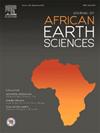利比亚中北部苏尔特盆地东北部退进三角洲体系特征与演化——层序地层构型及其控制因素
IF 2.2
4区 地球科学
Q2 GEOSCIENCES, MULTIDISCIPLINARY
引用次数: 0
摘要
该研究首次通过三维地震和电缆测井数据解释了苏尔特盆地的三角洲系统,苏尔特盆地是利比亚最大的沉积盆地,也是非洲产油最多的盆地。研究重点研究了苏尔特盆地东北部渐新统三角洲体系的内部沉积形态和层序地层构型。根据电缆测井响应,确定了三种主要的测井相:砂岩、粉砂岩和页岩。根据测井解释相及其垂向叠加模式、地震几何形状和沉积剖面位置,将三角洲体系划分为3个沉积相。分别为分流河道相、三角洲前缘相和前三角洲相。圈定了三个主要的同步和区域地层面,涵盖了整个研究重点,并延伸到三维地震调查的边界之外。三角洲体系形成三级沉积层序,由上下两个不整合层序边界所包围。它由两个体系域组成,两个体系域被一个最大淹没面隔开:底部是海侵体系域,顶部是回归体系域。三角洲层序进一步划分为11个四级层序。三角洲体系的发育主要受海平面变化和沉积物流入的控制。由于海平面上升,沉积物输入减少,三角洲系统向南退缩,泥沙负荷引起的沉降贡献较小。而泥沙淤积的增加则超过了可容纳空间的创造速度。此外,该研究还提供了沉积和层序地层结构、沉积机制以及沉积盆地稳定后裂谷阶段三角洲体系发展的见解。本文章由计算机程序翻译,如有差异,请以英文原文为准。
Characterization and evolution of a retrograding-prograding deltaic system, NE Sirte Basin, north-central Libya — Sequence stratigraphic architecture and controlling factors
This study presents the first deltaic system interpreted from three-dimensional seismic and wireline log data in the Sirte Basin, the largest sedimentary basin in Libya and most producing petroliferous basin in Africa. The research focuses on examining the internal sedimentary configuration and sequence stratigraphic architecture of an Oligocene deltaic system in the northeastern part of the Sirte Basin. Three major log facies were defined on the basis of wireline log responses: sandstone, siltstone, and shale. The deltaic system was subdivided into three sedimentary facies based on interpreted log facies and their vertical stacking patterns, seismic geometries, and position along the depositional profile. Those facies are distributary channel, delta front, and prodelta. Three major synchronous and regional stratigraphic surfaces were delineated, encompassing the whole study focus and extend beyond the boundaries of the 3D seismic survey. The deltaic system forms a third-order depositional sequence that is bounded by two unconformable sequence boundaries from below and above. It consists of two system tracts separated by a maximum flooding surface: a transgressive systems tract at the base capped by a regressive systems tract. The deltaic sequence is further subdivided into eleven fourth-order sequences. The development of the deltaic system was mainly controlled by sea-level changes and sediment influx. The deltaic system retreated to the south due to a rise in sea level, reduction in sediment input, with a minor contribution of subsidence resulting from sediment loading. While the progradation occurred as a result of increasing sediment influx that exceeded the creation rate of accommodation space. Additionally, the study provides insights onto the sedimentary and sequence stratigraphic structure, depositional mechanisms, and development of deltaic systems during a stable, post-rift stage of a sedimentary basin.
求助全文
通过发布文献求助,成功后即可免费获取论文全文。
去求助
来源期刊

Journal of African Earth Sciences
地学-地球科学综合
CiteScore
4.70
自引率
4.30%
发文量
240
审稿时长
12 months
期刊介绍:
The Journal of African Earth Sciences sees itself as the prime geological journal for all aspects of the Earth Sciences about the African plate. Papers dealing with peripheral areas are welcome if they demonstrate a tight link with Africa.
The Journal publishes high quality, peer-reviewed scientific papers. It is devoted primarily to research papers but short communications relating to new developments of broad interest, reviews and book reviews will also be considered. Papers must have international appeal and should present work of more regional than local significance and dealing with well identified and justified scientific questions. Specialised technical papers, analytical or exploration reports must be avoided. Papers on applied geology should preferably be linked to such core disciplines and must be addressed to a more general geoscientific audience.
 求助内容:
求助内容: 应助结果提醒方式:
应助结果提醒方式:


